As I was travelling with work and ‘hopping’ time zones, I thought it would be a great opportunity to put a GMT through its paces as an ideal travel companion and as Christopher ward have recently released their new Trident GMT (or more specifically, “C60 Trident GMT 600 Mk 3”) it seemed a great opportunity to spend some time with this watch and see how it measures up.
First impressions are good. The case is well designed and put together, and you can see that ChristopherWard have taken care with the design. It’s available in two case sizes – 38mm and 42mm which will suit both smaller and larger wrist sizes. The top and sides of the case are brushed with a polished bevelled edge separating the two. The case design incorporates integrated crown guards that are slender but sufficient, and the ChristopherWard logo is embossed on the crown itself. Overall, the watch feels solid, well designed and good quality for the price
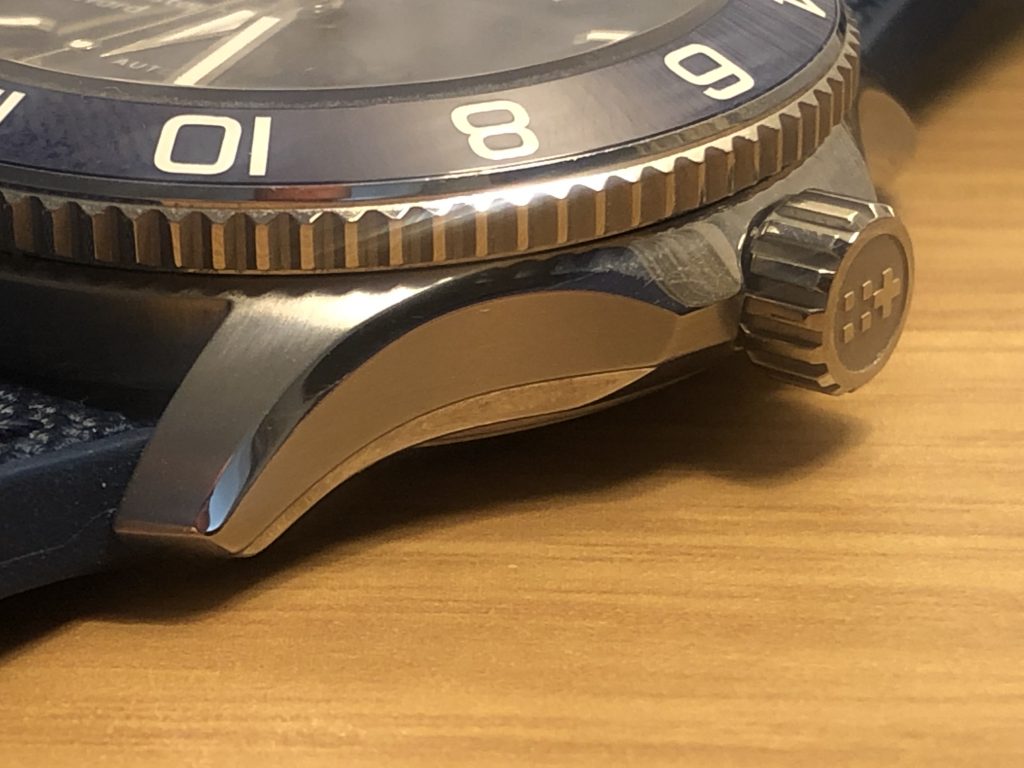
Turning the watch over reveals the caseback which has a beautifully engraved trident seal. It’s not laser engraved but deeply pressed into the caseback much in the same way that the ‘Hippocampus’ is engraved on the caseback of Omegas Seamaster range. In addition, there are 6 slots that form part of the design but are clearly there for a specialist case back opener.
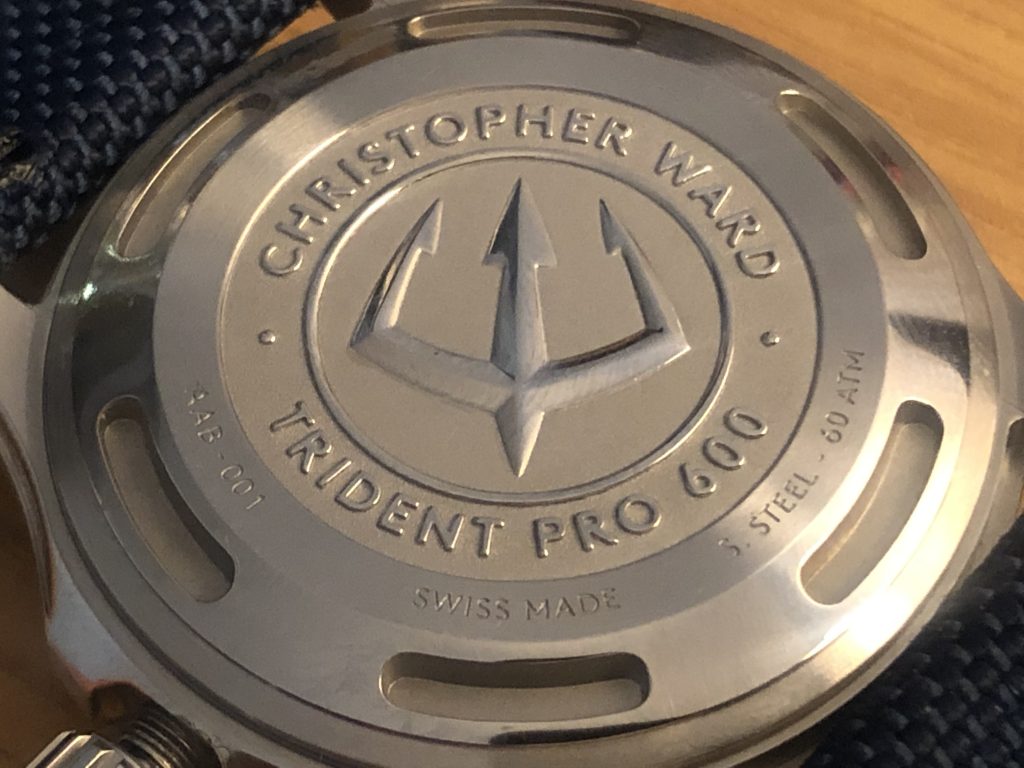
The dial is polished and features applied markers that hold a healthy amount of Grade X1 GL C1 Super-LumiNova® which is new for ChristopherWard. The hands also show an attention to detail with the counterbalance of the second hand also featuring the signature ‘Trident’ design, and the GMT hand in orange being a smaller iteration of the hour hand. They’re sharp and all contain a healthy application of lume.
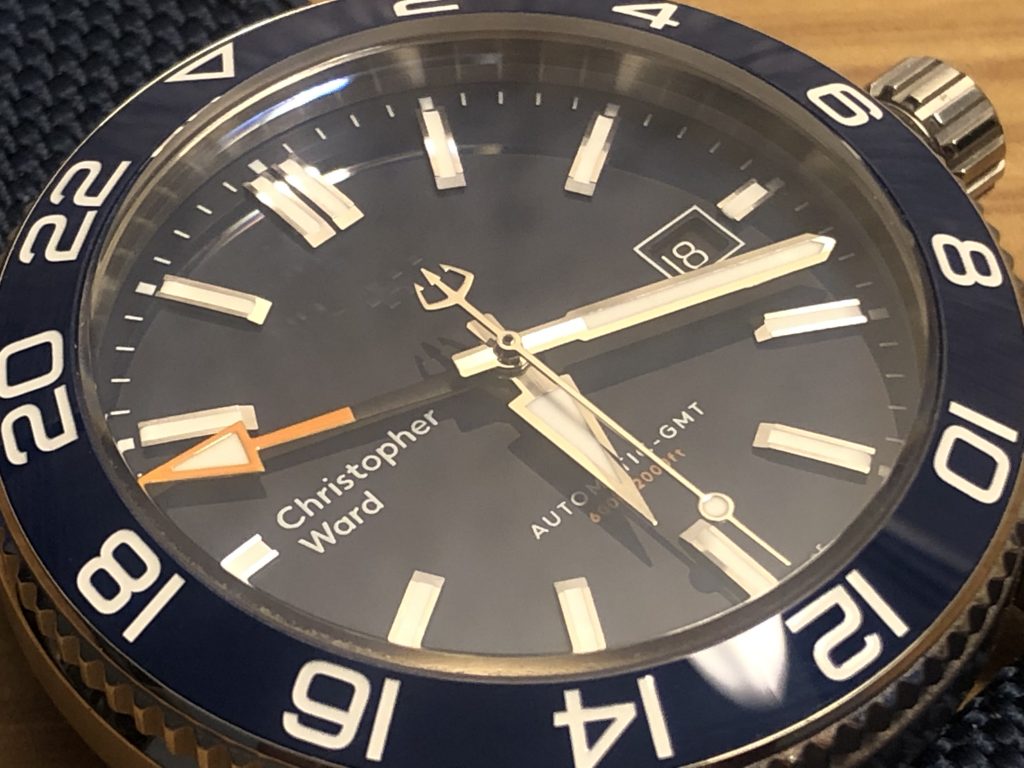
In addition, the hybrid rubber+fabric strap has been well thought through. The underside features channels to allow moisture to escape and as a nice touch it also has the ChristopherWard logo moulded into the design. The top of the strap features a cordura layer allowing the watch to have the practicalities of a rubber strap while maintaining the look of a fabric strap. The brushed buckle is signed and the strap includes quick release spring bars – allowing the owner to quickly change straps tool-free (which is great while travelling).
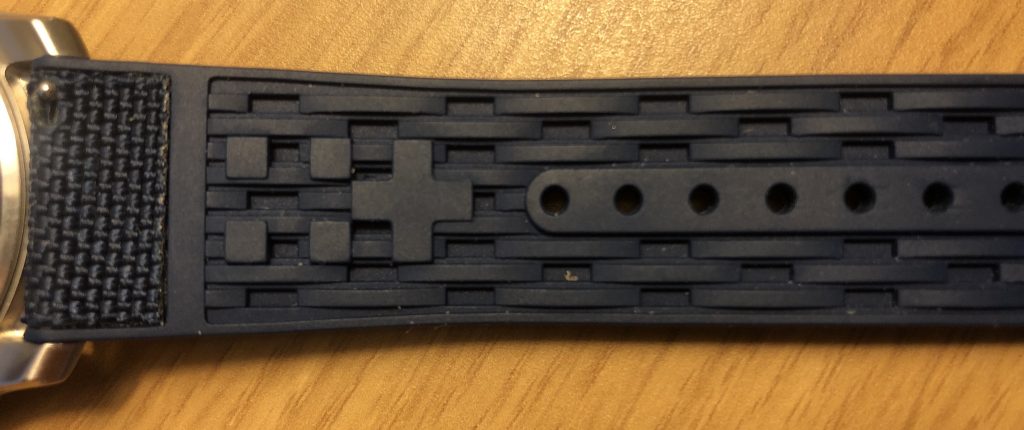
As a watch the trident is a competent timepiece. It’s rated to 600m which is far beyond the demands that any recreational diver will place on it. It has a simple design aesthetic that works well and Its unfussy and well built. So where do things start to come unstuck? Well it feel like the marriage of the two functions has compromised both. Lets start with the bezel.
The action is good and the teeth on the sides allow an easy grip for turning it. The size of the bezel shows a well thought out integration with the size and aesthetic of the watch case, and the ceramic blue insert is vibrant with the 24 hour markers filled with Super-LumiNova make it easy to read by day or night. However, It’s unidirectional which would imply it’s for monitoring dive times but there are no minute markers on the bezel for monitoring dive times as its inscribed with the 24 hour markers for the GMT hand. This means the bezel’s useless for divers and frustrating to use with the GMT hand as it doesn’t rotate in both directions. This was clearly not well thought through.
In truth, many other manufacturers also exhibit one of these two problems. Tudors BlackBay GMT and Omega’s PlanetOcean GMT (amongst many others) also cannot measure dive time as their bezels are populated with 24 hour markers. However they do have bi-directional bezels meaning they can easily allow the wearer to track multiple time zones. So in reality they are first and foremost GMT watches that are built to survive deep water immersion rather than being proper divers watches.
However, in the case of the Trident GMT, the movement is also fundamentally flawed in its operation as a GMT but this is a little more complicated to explain..
In an integrated GMT movement architecture, the movement works a little differently. Firstly the movement drives three hands for the main timekeeping but these are not what you would expect. They are the seconds, minutes, and the 24 hour hand (often referred to as the GMT hand) rather than the normal 12 hour hand. This allows the primary reference time to be constant and is all set with the watch as if adjusting the time as normal (by pulling the crown out two positions causing the watch to ‘hack’ or stop). In addition to this but independently set is an additional 12 hour hand that is also connected to the date wheel. This allows the wearer to quickly adjust the hour hand forwards or backwards an hour at a time, and where it crosses the 12 o’clock position at midnight, it moves the date forward or backwards as required. This is the only way of setting the date on a GMT. Yes that’s right, on a purpose designed GMT movement, you can wind the hour hand backwards and if it crosses the midnight position it will happily wind the date backwards one day.
To a user the whole process of operating it is extremely easy. The watch will run with the reference time set and when crossing time zones simply pull out the crown one position and move the hour hand forward or backwards one hour at a time without stopping the watch ensuring accurate timekeeping is maintained.
Christoper Ward have chosen to use the ETA 2893 modular GMT movement to power the C60 Trident GMT. I can understand why Christopher ward would want to do this – ETA are a massive movement maker that supply a variety of complications to suit watchmakers worldwide with a proven reliability, easy servicing and a brand recognition that allows them to sell a watch with a Swiss movement. However In order to build a modular movement you need to not only operate the primary timekeeping functions of the watch but also provide a connection to deliver power to the additional module. This allows the base movement to be used as a timekeeping movement in its own right (in this case on its own it is the ETA 2892-2 base movement), and for its functionality to be extended depending on which module is fitted on top. This means that the module on top (in this case ETAs GMT module) has to run the 24 hour hand but it also has be able of being independently set. This is done buy pulling out the crown to the first position and instead of winding the crown backwards to advance the date, you have to wind it forward to move the GMT hand forward by an hour at a time. This is the direct opposite of how you expect a GMT to work where the GMT hand maintains a constant (Showing the time at the Greenwich Meridian) and the local time is adjusted independantly.
It means that every time you move to a different time zone you have to…
- Pull the crown out two positions stopping the watch, adjust the time of the watch to the new time zone moving all the hands on the watch (NOT back past midnight) and having to use another reference time as now the watch has stopped so it’s no longer accurate.
- Next push the crown back in one position and wind the crown forwards to return the GMT hand back to where it should be.
- Next wind the crown backwards to advance the date (if necessary) all the way round 30 positions (if retarding the time causes you to pass midnight and hence now showing the previous day).
- Lastly press the crown in again to finish setting the time and date and screw the crown down ensuring its water tight once again.
As you can see this is extremely frustrating and you only have to do this a couple of times to realise how flawed this movement architecture is. Frequent travellers will quickly become disillusioned with a GMT like this.
I must point out that this is not a criticism of Christopher ward – they don’t produce movements themselves and have to buy these in from a supplier. The experience here will be exactly the same for other manufacturers who all rely on ETA to supply them with a GMT movement.
With this in mind I feel here that the marriage of both a divers watch and GMT have been fundamentally compromised. You cant measure dive time on it, and you cant easily switch time zones.
As I returned from my trip I was deeply torn. At face value its specified well and the build quality is great. Had this been purely a focused divers watch, with a gratuated dive-time bezel, It would have been hard to fault. However, the main selling point of the watch is as a GMT and in this regard its exasperating to use! There is one thing that the trip has taught me – the value of a properly designed and integrated GMT movement architecture!
Links to items in this article:
ChristopherWard Trident GMT

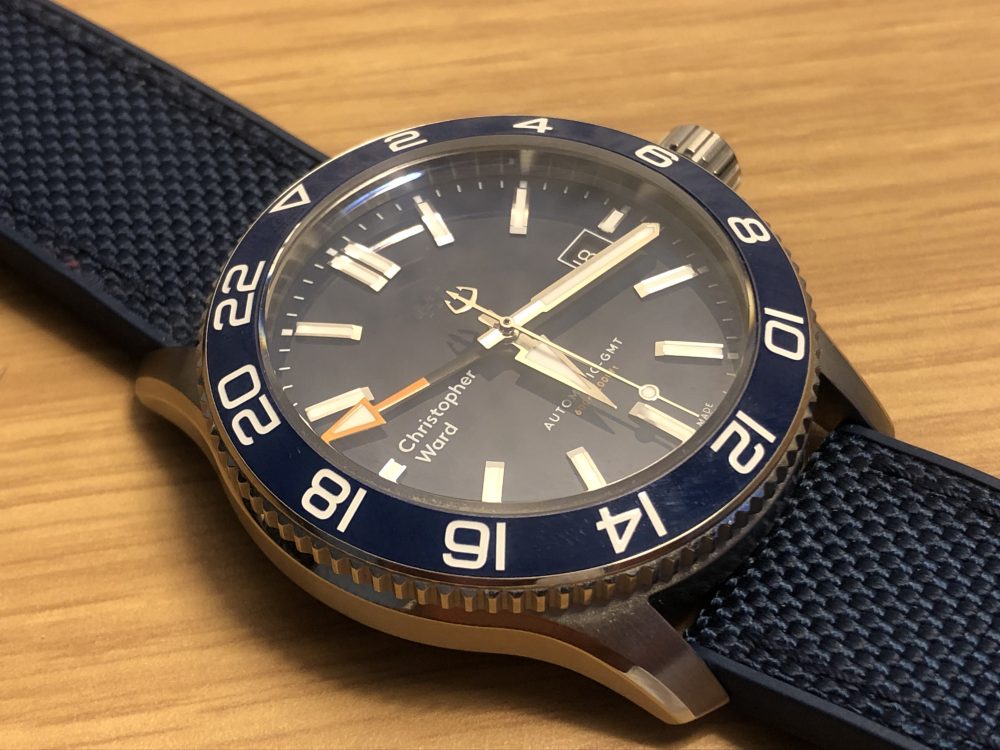
1 Comment
Incredible points. Outstanding arguments. Keep up the good work.